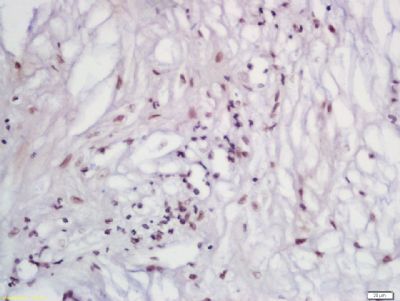
Angiotensin I,血管紧张素I抗体
产品名称: Angiotensin I,血管紧张素I抗体
英文名称: Anti-Angiotensin I antibody
产品编号: HZ-1707R
产品价格: null
产品产地: 中国/美国
品牌商标: HZbscience
更新时间: 2023-08-17T10:24:20
使用范围: WB,ELISA,IHC-P,IHC-F,IF
- 联系人 : 鲍丽雯
- 地址 : 上海市闵行区闵北路88弄1-30号第22幢AQ136室
- 邮编 : 200612
- 所在区域 : 上海
- 电话 : 139****0749 点击查看
- 传真 : 点击查看
- 邮箱 : www.shzbio.net
- 二维码 : 点击查看
Angiotensin I,血管紧张素I抗体
产品编号HZ-1707R
英文名称Angiotensin I
中文名称血管紧张素I抗体
别 名AGT; Alpha 1 antiproteinase antitrypsin; Ang I; Ang II; Ang III; Angiotensin 1; Angiotensin; Angiotensin I; Angiotensin II; Angiotensin-2; Angiotensin III; Angiotensin-3; Angiotensinogen; Angiotensinogen serpin peptidase inhibitor clade A member 8; ANGT_HUMAN; Angiotensin 1-10; Angiotensin 1-8; ANHU; Des-Asp[1]-angiotensin II; FLJ92595; FLJ97926; OTTHUMP00000035878; Pre angiotensinogen; Serine or cysteine proteinase inhibitor; Serpin A8; Serpin peptidase inhibitor, clade A, member 8; SERPINA8.
规格价格0.1ml 0.2ml
说 明 书0.1ml 0.2ml
研究领域肿瘤 心血管 细胞生物 生长因子和激素 新陈代谢
抗体来源Rabbit
Angiotensin I,血管紧张素I抗体克隆类型Polyclonal
交叉反应Human, Mouse, Rat, Dog, Horse, Sheep,
产品应用ELISA=1:500-1000 IHC-P=1:100-500 IHC-F=1:100-500 IF=1:100-500 (石蜡切片需做抗原修复)
not yet tested in other applications.
optimal dilutions/concentrations should be determined by the end user.
分 子 量50kDa
细胞定位分泌型蛋白
性 状Lyophilized or Liquid
浓 度1mg/1ml
免 疫 原KLH conjugated synthetic peptide of human Angiotensin I(DRVYIHPFHL)
亚 型IgG
纯化方法affinity purified by Protein A
储 存 液0.01M TBS(pH7.4) with 1% BSA, 0.03% Proclin300 and 50% Glycerol.
保存条件Store at -20 °C for one year. Avoid repeated freeze/thaw cycles. The lyophilized antibody is stable at room temperature for at least one month and for greater than a year when kept at -20°C. When reconstituted in sterile pH 7.4 0.01M PBS or diluent of antibody the antibody is stable for at least two weeks at 2-4 °C.
Angiotensin I,血管紧张素I抗体PubMedPubMed
产品介绍background:
The protein encoded by this gene, pre-angiotensinogen or angiotensinogen precursor, is expressed in the liver and is cleaved by the enzyme renin in response to lowered blood pressure. The resulting product, angiotensin I is then cleaved by angiotensin converting enzyme (ACE) to generate the physiologically active enzyme angiotensin II. The protein is involved in maintaining blood pressure and in the pathogenesis of essential hypertension and preeclampsia.
active peptide sequence:DRVYIHPFHL
Function:
Essential component of the renin-angiotensin system (RAS), a potent regulator of blood pressure, body fluid and electrolyte homeostasis.
Angiotensin-2: acts directly on vascular smooth muscle as a potent vasoconstrictor, affects cardiac contractility and heart rate through its action on the sympathetic nervous system, and alters renal sodium and water absorption through its ability to stimulate the zona glomerulosa cells of the adrenal cortex to synthesize and secrete aldosterone.
Angiotensin-3: stimulates aldosterone release.
Angiotensin 1-7: is a ligand for the G-protein coupled receptor MAS1 (By similarity). Has vasodilator and antidiuretic effects (By similarity). Has an antithrombotic effect that involves MAS1-mediated release of nitric oxide from platelets (By similarity).
Subunit:
During pregnancy, exists as a disulfide-linked 2:2 heterotetramer with the proform of PRG2 and as a complex (probably a 2:2:2 heterohexamer) with pro-PRG2 and C3dg.
Angiotensin I,血管紧张素I抗体Subcellular Location:
Secreted.
Tissue Specificity:
Expressed by the liver and secreted in plasma.
Post-translational modifications:
Beta-decarboxylation of Asp-34 in angiotensin-2, by mononuclear leukocytes produces alanine. The resulting peptide form, angiotensin-A, has the same affinity for the AT1 receptor as angiotensin-2, but a higher affinity for the AT2 receptor.
In response to low blood pressure, the enzyme renin/REN cleaves angiotensinogen to produce angiotensin-1. Angiotensin-1 is a substrate of ACE (angiotensin converting enzyme) that removes a dipeptide to yield the physiologically active peptide angiotensin-2. Angiotensin-1 and angiotensin-2 can be further processed to generate angiotensin-3, angiotensin-4. Angiotensin 1-9 is cleaved from angiotensin-1 by ACE2 and can be further processed by ACE to produce angiotensin 1-7, angiotensin 1-5 and angiotensin 1-4. Angiotensin 1-7 has also been proposed to be cleaved from angiotensin-2 by ACE2 or from angiotensin-1 by MME (neprilysin).
The disulfide bond is labile. Angiotensinogen is present in the circulation in a near 40:60 ratio with the oxidized disulfide-bonded form, which preferentially interacts with receptor-bound renin.
DISEASE:
Essential hypertension (EHT) [MIM:145500]: A condition in which blood pressure is consistently higher than normal with no identifiable cause. Note=Disease susceptibility is associated with variations affecting the gene represented in this entry.
Renal tubular dysgenesis (RTD) [MIM:267430]: Autosomal recessive severe disorder of renal tubular development characterized by persistent fetal anuria and perinatal death, probably due to pulmonary hypoplasia from early-onset oligohydramnios (the Potter phenotype). Note=The disease is caused by mutations affecting the gene represented in this entry.
Similarity:
Belongs to the serpin family.
Gene ID:
183
Database links:
Entrez Gene: 183 Human
Entrez Gene: 11606 Mouse
Entrez Gene: 24179 Rat
Omim: 106150 Human
SwissProt: P01019 Human
SwissProt: P11859 Mouse
SwissProt: P01015 Rat
SwissProt: P20757 Sheep
Unigene: 19383 Human
Unigene: 301626 Mouse
Unigene: 6319 Rat
Important Note:
This product as supplied is intended for research use only, not for use in human, therapeutic or diagnostic applications.

